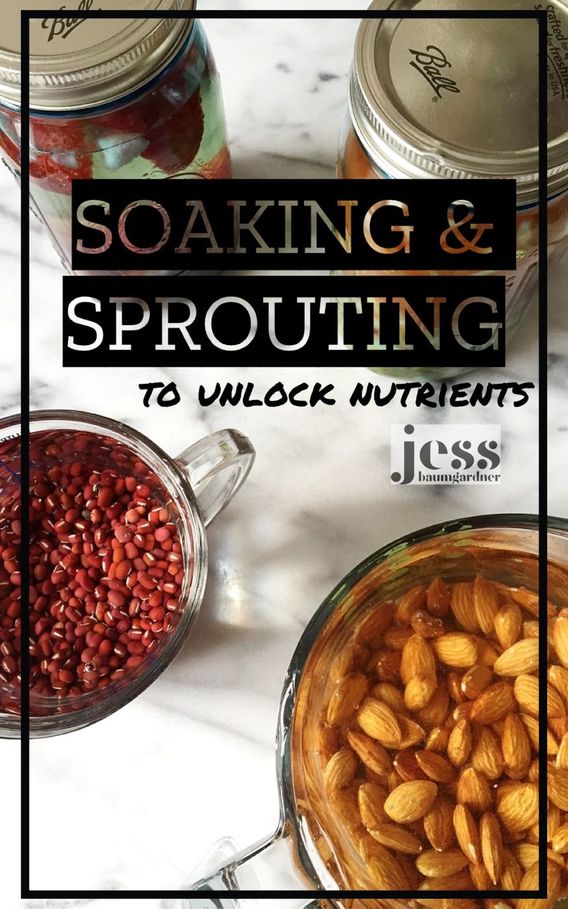why soak & sprout?
the benefits
Soaking and sprouting nuts, seeds, and grains can help to remove enzyme inhibitors such as phytates, which in turn - can greatly increase their nutrient bioavailability. AKA your ability to use the nutrients you eat.
In the plant world – phytates prevent premature germination and store the phosphorus that plants need to grow. The phosphorus packaged in phytates bonds to calcium, iron, magnesium and zinc, making them hard for the body to absorb. Enzyme inhibitors such as phytic acid, keep these foods in their dormant state, so their nutrients cannot be fully accessed until they are soaked and/or sprouted.
Our goal is to break down or reduce the phytates. Soaking, sprouting, fermenting, juicing, and blending can help us do that.
When something is sprouted, or germinated - enzymes are released to break down anti-nutrients so that the stored starches and protein become available for the plant to grow - this process also prepares the nutrients in the legume to be more nutritious and easily absorbed for us as well. It will also increase the vitamin C and vitamin B content,while at the same time help reduce many of the enzyme inhibitors that can make phytate-containing foods irritating to the gut lining, and very hard to digest.
It’s interesting that many times if you have a sensitivity to something, you won’t notice it as strong when it is soaked and sprouted!
You can do the soaking and sprouting process yourself, or you can look for products at the grocery store that have completed this process for you! Just look for a notice on the label that says the grain, bean, etc. has been sprouted.
what is soaking?
Soaking helps to remove enzyme inhibitors so that the thing you are soaking can sprout (or, germinate), while also improving the digestion of these foods and the nutrients they contain.Soaking helps to break down the complex sugars, fats, and proteins into simpler constituents that are more easily assimilated by the body.
Lastly - you want to soak nuts and seeds to remove dust, residue from processing and shipping, and tannins, which will just make them taste better!
How To?
Use purified water to cover the nut, seed or legume you are soaking. I usually just use a glass mason jar or measuring cup. Ideally, soaking should be at room temperature and in general, denser nuts require longer soaking time.You want to soak a food until it is just soft enough, but never too long, or you risk the food becoming rancid or allowing mold to grow. Adding a bit of an acidic medium to the soaking water, such as lemon juice or vinegar, can also further aid in the removal of phytates.
what is sprouting?
It’s the germination of seeds and grains, which ultimately helps to improve their digestibility. The vitamin content and bioavailability of minerals will increase with sprouting.
How to?
1. Rinse the seeds or grains well and pour into a jar
2. Then fill the jar at least 3⁄4 full of water
3. Soak overnight (but check timing for each specific item you soak!) at room temperature.
4. Pour out the water and seeds and rinse with fresh water and strain.
5. Return the seeds to the jar.
6. Cover the jar with cheesecloth and secure it with a rubber band.
7. Briefly turn the jar upside down to drain the remaining water.
8. Sprouts will begin to appear within 24 hours or so.
9. Make sure the sprouts stay moist. This is important so that they actually sprout! You can do this by rinsing and draining them 1-2 times each day until they have reached the desired growth you want.
10. Rinse your sprouts before eating!
examples & sprouting and soaking times
Almonds – soak 8-12 hours
Cashews – soak 2-6 hours
Walnuts – soak 4-7 hours
Sunflower Seeds – soak 6-8 hours
Adzuki Beans
1 cup will yield cups sprouts
Soak 8-12 hours
Sprout 3-5 days
Chia Seeds
1 cup will yield 1 1/2-2 cups gelled seeds
Soak 4 hours
Sprout 1-4 days
Garbanzo Beans
1 cup will yield 2 cups sprouts
Soak 12-48 hours
Sprout 2-4 days
Flax Seeds
1 cup seeds will yield 2 cups
Soak 6 hours
Sprout 1-5 days
Lentils
1 cup will yield 2 cups sprouts
Soak 8 hours
Sprout 2-3 days
Quinoa
1 cup seeds will yield 4 cups sprouts
Soak 3-4 hours
Sprout 2-3 days
Recipes
Romaine Caesar Salad with Cashew Dressing, Crouton, Mushroom Anchovies and Almond Parmesan
Caesar dressing
¼ cup soaked cashews seeds
¼ cup water
2 tbsp lemon juice
1 celery stalk, chopped
2 tbsp tamari
½ tbsp miso
½ tbsp apple cider vinegar
Black pepper to taste
½ clove garlic
½ cup olive oil
Blend all ingredients, except olive oil, until smooth. Stream in olive oil while blending at low speed. Adjust salt to taste.
Serve on top of fresh romaine lettuce with the crouton, anchovies and parmesan below! Feel free to get creative with your salad and add roasted vegetables, tofu or protein of choice.
crouton
1 cup sunflower seeds or cashews, soaked
¼ cup water
½ tsp olive oil
1 tbsp lemon juice
1 tbsp nutritional yeast
½ tsp salt
Process all ingredients, in a food processor until smooth. Pour contents of processor into a bowl.
Spread mixture onto a silpat/parchment paper on a sheet pan and bake 10-20 minutes until crisp
Mushroom “anchovies”
½ tbsp tamari
1 tbsp apple cider vinegar
½ tsp olive oil
½ cup sliced mushrooms
Mix tamari, vinegar, oil, and salt in a bowl, and add sliced mushrooms to coat. Add them to a baking sheet and bake on 350 until chewy, about 15 minutes.
“parmesan”
¼ cup almond flour
¼ cup nutritional yeast
1⁄4 tsp salt
Mix together and use to sprinkle on top of salad.
